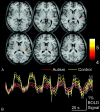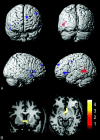Decreased left posterior insular activity during auditory language in autism
- PMID: 19749222
- PMCID: PMC2807479
- DOI: 10.3174/ajnr.A1789
Decreased left posterior insular activity during auditory language in autism
Abstract
Background and purpose: Individuals with autism spectrum disorders often exhibit atypical language patterns, including delay of speech onset, literal speech interpretation, and poor recognition of social and emotional cues in speech. We acquired functional MR images during an auditory language task to evaluate systematic differences in language-network activation between control and high-functioning autistic populations.
Materials and methods: Forty-one right-handed male subjects (26 high-functioning autistic subjects, 15 controls) were studied by using an auditory phrase-recognition task, and areas of differential activation between groups were identified. Hand preference, verbal intelligence quotient (IQ), age, and language-function testing were included as covariables in the analysis.
Results: Control and autistic subjects showed similar language-activation networks, with 2 notable differences. Control subjects showed significantly increased activation in the left posterior insula compared with autistic subjects (P < .05, false discovery rate), and autistic subjects showed increased bilaterality of receptive language compared with control subjects. Higher receptive-language scores on standardized testing were associated with greater activation of the posterior aspect of the left Wernicke area. A higher verbal IQ was associated with greater activation of the bilateral Broca area and involvement of the prefrontal cortex and lateral premotor cortex.
Conclusions: Control subjects showed greater activation of the posterior insula during receptive language, which may correlate with impaired emotive processing of language in autism. Subjects with autism showed greater bilateral activation of receptive-language areas, which was out of proportion to the differences in hand preference in autism and control populations.
Figures





References
-
- Howlin P, Goode S, Hutton J, et al. . Adult outcome for children with autism. J Child Psychol Psychiatry 2004; 45: 212–29 - PubMed
-
- Diagnostic and Statistical Manual of Mental Disorders DSM-IV-TR. 4th ed. Washington, DC: American Psychiatric Association; 2000
-
- Raichle ME. Visualizing the mind. Sci Am 1994; 270: 58–64 - PubMed
-
- Gomot M, Bernard FA, Davis MH, et al. . Change detection in children with autism: an auditory event-related fMRI study. Neuroimage 2006; 29: 475–84 - PubMed
Publication types
MeSH terms
Grants and funding
LinkOut - more resources
Full Text Sources
Medical
